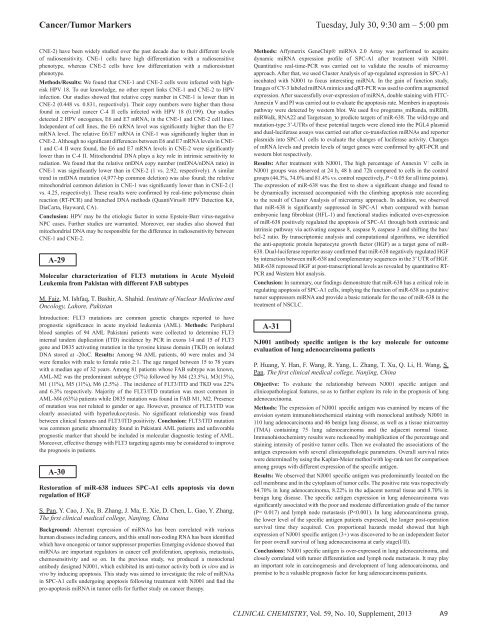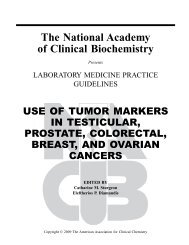Abstracts of the Scientific Posters, 2013 AACC Annual Meeting ...
Abstracts of the Scientific Posters, 2013 AACC Annual Meeting ...
Abstracts of the Scientific Posters, 2013 AACC Annual Meeting ...
You also want an ePaper? Increase the reach of your titles
YUMPU automatically turns print PDFs into web optimized ePapers that Google loves.
Cancer/Tumor Markers<br />
Tuesday, July 30, 9:30 am – 5:00 pm<br />
CNE-2) have been widely studied over <strong>the</strong> past decade due to <strong>the</strong>ir different levels<br />
<strong>of</strong> radiosensitivity. CNE-1 cells have high differentiation with a radiosensitive<br />
phenotype, whereas CNE-2 cells have low differentiation with a radioresistant<br />
phenotype.<br />
Methods/Results: We found that CNE-1 and CNE-2 cells were infected with highrisk<br />
HPV 18. To our knowledge, no o<strong>the</strong>r report links CNE-1 and CNE-2 to HPV<br />
infection. Our studies showed that relative copy number in CNE-1 is lower than in<br />
CNE-2 (0.448 vs. 0.831, respectively). Their copy numbers were higher than those<br />
found in cervical cancer C-4 II cells infected with HPV 18 (0.199). Our studies<br />
detected 2 HPV oncogenes, E6 and E7 mRNA, in <strong>the</strong> CNE-1 and CNE-2 cell lines.<br />
Independent <strong>of</strong> cell lines, <strong>the</strong> E6 mRNA level was significantly higher than <strong>the</strong> E7<br />
mRNA level. The relative E6/E7 mRNA in CNE-1 was significantly higher than in<br />
CNE-2. Although no significant differences between E6 and E7 mRNA levels in CNE-<br />
1 and C-4 II were found, <strong>the</strong> E6 and E7 mRNA levels in CNE-2 were significantly<br />
lower than in C-4 II. Mitochondrial DNA plays a key role in intrinsic sensitivity to<br />
radiation. We found that <strong>the</strong> relative mtDNA copy number (mtDNA/nDNA ratio) in<br />
CNE-1 was significantly lower than in CNE-2 (1 vs. 2.92, respectively). A similar<br />
trend in mtDNA mutation (4,977-bp common deletion) was also found; <strong>the</strong> relative<br />
mitochondrial common deletion in CNE-1 was significantly lower than in CNE-2 (1<br />
vs. 4.25, respectively). These results were confirmed by real-time polymerase chain<br />
reaction (RT-PCR) and branched DNA methods (QuantiVirus® HPV Detection Kit,<br />
DiaCarta, Hayward, CA).<br />
Conclusion: HPV may be <strong>the</strong> etiologic factor in some Epstein-Barr virus-negative<br />
NPC cases. Fur<strong>the</strong>r studies are warranted. Moreover, our studies also showed that<br />
mitochondrial DNA may be responsible for <strong>the</strong> difference in radiosensitivity between<br />
CNE-1 and CNE-2.<br />
A-29<br />
Molecular characterization <strong>of</strong> FLT3 mutations in Acute Myeloid<br />
Leukemia from Pakistan with different FAB subtypes<br />
M. Faiz, M. Ishfaq, T. Bashir, A. Shahid. Institute <strong>of</strong> Nuclear Medicine and<br />
Oncology, Lahore, Pakistan<br />
Introduction: FLT3 mutations are common genetic changes reported to have<br />
prognostic significance in acute myeloid leukemia (AML). Methods: Peripheral<br />
blood samples <strong>of</strong> 94 AML Pakistani patients were collected to determine FLT3<br />
internal tandem duplication (ITD) incidence by PCR in exons 14 and 15 <strong>of</strong> FLT3<br />
gene and D835 activating mutation in <strong>the</strong> tyrosine kinase domain (TKD) on isolated<br />
DNA stored at -20oC. Results: Among 94 AML patients, 60 were males and 34<br />
were females with male to female ratio 2:1. The age ranged between 15 to 78 years<br />
with a median age <strong>of</strong> 32 years. Among 81 patients whose FAB subtype was known,<br />
AML-M2 was <strong>the</strong> predominant subtype (37%) followed by M4 (23.5%), M3(15%),<br />
M1 (11%), M5 (11%), M6 (2.5%) . The incidence <strong>of</strong> FLT3/ITD and TKD was 22%<br />
and 6.3% respectively. Majority <strong>of</strong> <strong>the</strong> FLT3/ITD mutation was most common in<br />
AML-M4 (63%) patients while D835 mutation was found in FAB M1, M2. Presence<br />
<strong>of</strong> mutation was not related to gender or age. However, presence <strong>of</strong> FLT3/ITD was<br />
clearly associated with hyperleukocytosis. No significant relationship was found<br />
between clinical features and FLT3/ITD positivity. Conclusion: FLT3/ITD mutation<br />
was common genetic abnormality found in Pakistani AML patients and unfavorable<br />
prognostic marker that should be included in molecular diagnostic testing <strong>of</strong> AML.<br />
Moreover, effective <strong>the</strong>rapy with FLT3 targeting agents may be considered to improve<br />
<strong>the</strong> prognosis in patients.<br />
A-30<br />
Restoration <strong>of</strong> miR-638 induces SPC-A1 cells apoptosis via down<br />
regulation <strong>of</strong> HGF<br />
S. Pan, Y. Cao, J. Xu, B. Zhang, J. Ma, E. Xie, D. Chen, L. Gao, Y. Zhang.<br />
The fi rst clinical medical college, Nanjing, China<br />
Background: Aberrant expression <strong>of</strong> miRNAs has been correlated with various<br />
human diseases including cancers, and this small non-coding RNA has been identified<br />
which have oncogenic or tumor suppressor properties Emerging evidence showed that<br />
miRNAs are important regulators in cancer cell proliferation, apoptosis, metastasis,<br />
chemosensitivity and so on. In <strong>the</strong> previous study, we produced a monoclonal<br />
antibody designed NJ001, which exhibited its anti-tumor activity both in vitro and in<br />
vivo by inducing apoptosis. This study was aimed to investigate <strong>the</strong> role <strong>of</strong> miRNAs<br />
in SPC-A1 cells undergoing apoptosis following treatment with NJ001 and find <strong>the</strong><br />
pro-apoptosis miRNA in tumor cells for fur<strong>the</strong>r study on cancer <strong>the</strong>rapy.<br />
Methods: Affymetrix GeneChip® miRNA 2.0 Array was performed to acquire<br />
dynamic miRNA expression pr<strong>of</strong>ile <strong>of</strong> SPC-A1 after treatment with NJ001.<br />
Quantitative real-time-PCR was carried out to validate <strong>the</strong> results <strong>of</strong> microarray<br />
approach. After that, we used Cluster Analysis <strong>of</strong> up-regulated expression in SPC-A1<br />
incubated with NJ001 to focus interesting miRNA. In <strong>the</strong> gain <strong>of</strong> function study,<br />
Images <strong>of</strong> CY-3 labeled miRNA mimics and qRT-PCR was used to confirm augmented<br />
expression. After successfully over-expression <strong>of</strong> miRNA, double staining with FITC-<br />
Annexin V and PI was carried out to evaluate <strong>the</strong> apoptosis rate. Members in apoptosis<br />
pathway were detected by western blot. We used five programs_miRanda, miRDB,<br />
miRWalk, RNA22 and Targetscan_to predicte targets <strong>of</strong> miR-638. The wild-type and<br />
mutation-type 3’-UTRs <strong>of</strong> <strong>the</strong>se potential targets were cloned into <strong>the</strong> PGL4 plasmid<br />
and dual-luciferase assays was carried out after co-transfection miRNAs and reporter<br />
plasmids into SPC-A1 cells to evaluate <strong>the</strong> changes <strong>of</strong> luciferase activity. Changes<br />
<strong>of</strong> mRNA levels and protein levels <strong>of</strong> target genes were confirmed by qRT-PCR and<br />
western blot respectively.<br />
Results: After treatment with NJ001, The high percentage <strong>of</strong> Annexin V + cells in<br />
NJ001 groups was observed at 24 h, 48 h and 72h compared to cells in <strong>the</strong> control<br />
groups (44.3%, 74.0% and 81.4% vs. control respectively, P < 0.05 for all time points).<br />
The expression <strong>of</strong> miR-638 was <strong>the</strong> first to show a significant change and found to<br />
be dynamically increased accompanied with <strong>the</strong> climbing apoptosis rate according<br />
to <strong>the</strong> result <strong>of</strong> Cluster Analysis <strong>of</strong> microarray approach. In addition, we observed<br />
that miR-638 is significantly suppressed in SPC-A1 when compared with human<br />
embryonic lung fibroblast (HFL-1) and functional studies indicated over-expression<br />
<strong>of</strong> miR-638 positively regulated <strong>the</strong> apoptosis <strong>of</strong> SPC-A1 through both extrinsic and<br />
intrinsic pathway via activating caspase 8, caspase 9, caspase 3 and shifting <strong>the</strong> bax/<br />
bcl-2 ratio. By transcriptomic analysis and computational algorithms, we identified<br />
<strong>the</strong> anti-apoptotic protein hepatocyte growth factor (HGF) as a target gene <strong>of</strong> miR-<br />
638. Dual-luciferase reporter assay confirmed that miR-638 negatively regulated HGF<br />
by interaction between miR-638 and complementary sequences in <strong>the</strong> 3’ UTR <strong>of</strong> HGF.<br />
MiR-638 repressed HGF at post-transcriptional levels as revealed by quantitative RT-<br />
PCR and Western blot analysis.<br />
Conclusion: In summary, our findings demonstrate that miR-638 has a critical role in<br />
regulating apoptosis <strong>of</strong> SPC-A1 cells, implying <strong>the</strong> function <strong>of</strong> miR-638 as a putative<br />
tumor suppressors miRNA and provide a basic rationale for <strong>the</strong> use <strong>of</strong> miR-638 in <strong>the</strong><br />
treatment <strong>of</strong> NSCLC.<br />
A-31<br />
NJ001 antibody specific antigen is <strong>the</strong> key molecule for outcome<br />
evaluation <strong>of</strong> lung adenocarcinoma patients<br />
P. Huang, Y. Han, F. Wang, R. Yang, L. Zhang, T. Xu, Q. Li, H. Wang, S.<br />
Pan. The fi rst clinical medical college, Nanjing, China<br />
Objective: To evaluate <strong>the</strong> relationship between NJ001 specific antigen and<br />
clinicopathological features, so as to fur<strong>the</strong>r explore its role in <strong>the</strong> prognosis <strong>of</strong> lung<br />
adenocarcinoma.<br />
Methods: The expression <strong>of</strong> NJ001 specific antigen was examined by means <strong>of</strong> <strong>the</strong><br />
envision system immunohistochemical staining with monoclonal antibody NJ001 in<br />
110 lung adenocarcinoma and 46 benign lung disease, as well as a tissue microarray<br />
(TMA) containing 75 lung adenocarcinoma and <strong>the</strong> adjacent normal tissue.<br />
Immunohistochemistry results were reckoned by multiplication <strong>of</strong> <strong>the</strong> percentage and<br />
staining intensity <strong>of</strong> positive tumor cells. Then we evaluated <strong>the</strong> associations <strong>of</strong> <strong>the</strong><br />
antigen expression with several clinicopathologic parameters. Overall survival rates<br />
were determined by using <strong>the</strong> Kaplan-Meier method with log-rank test for comparison<br />
among groups with different expression <strong>of</strong> <strong>the</strong> specific antigen.<br />
Results: We observed that NJ001 specific antigen was predominantly located on <strong>the</strong><br />
cell membrane and in <strong>the</strong> cytoplasm <strong>of</strong> tumor cells. The positive rate was respectively<br />
84.70% in lung adenocarcinoma, 8.22% in <strong>the</strong> adjacent normal tissue and 8.70% in<br />
benign lung disease. The specific antigen expression in lung adenocarcinoma was<br />
significantly associated with <strong>the</strong> poor and moderate differentiation grade <strong>of</strong> <strong>the</strong> tumor<br />
(P= 0.017) and lymph node metastasis (P
















